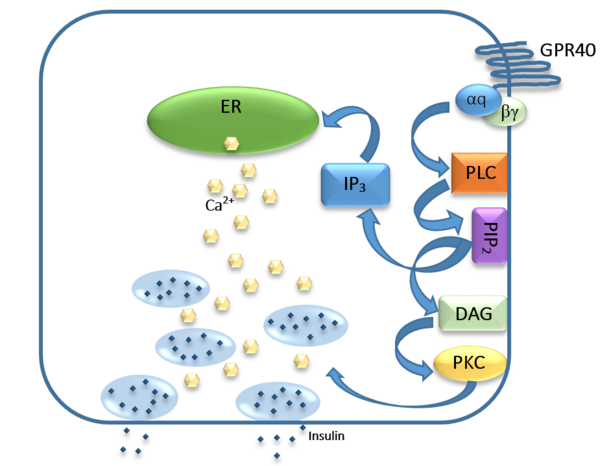User:Brittany Stankavich/Sandbox 1
From Proteopedia
| Line 15: | Line 15: | ||
== Signal Transduction == | == Signal Transduction == | ||
| + | |||
| + | [[Image:Gpr40 insulin pathway.png|600 px|center|hGPR40]] | ||
FFAs bind to GPR40 which then couples with the G-protein Gq leading to increased phospholipase C (PLC) activity. PLC catalyzes the hydrolysis of the phospholipid phosphatidylinositol-4,5-biphosphate (PIP2) resulting in the formation of diacylglycerol (DAG) and inositol 1,4,5-triphosphate (IP3). DAG can activate protein kinase C (PKC) to enhance insulin secretion. IP3 on the other hand is soluble and diffuses to the endoplasmic reticulum where it is able to bind to a receptor on a ligand-gated Ca2+ channel. This binding triggers the opening of the channel causing stored Ca2+ to be released into the cytoplasm. Upon this large increase in intracellular free Ca2+, there is also an increase in glucose-dependent insulin secretion suggesting that insulin release can be contributed in part to the changes in Ca2+ concentration resulting from activated GPR40. | FFAs bind to GPR40 which then couples with the G-protein Gq leading to increased phospholipase C (PLC) activity. PLC catalyzes the hydrolysis of the phospholipid phosphatidylinositol-4,5-biphosphate (PIP2) resulting in the formation of diacylglycerol (DAG) and inositol 1,4,5-triphosphate (IP3). DAG can activate protein kinase C (PKC) to enhance insulin secretion. IP3 on the other hand is soluble and diffuses to the endoplasmic reticulum where it is able to bind to a receptor on a ligand-gated Ca2+ channel. This binding triggers the opening of the channel causing stored Ca2+ to be released into the cytoplasm. Upon this large increase in intracellular free Ca2+, there is also an increase in glucose-dependent insulin secretion suggesting that insulin release can be contributed in part to the changes in Ca2+ concentration resulting from activated GPR40. | ||
Revision as of 11:51, 31 March 2016
- User:Brittany Stankavich/Sandbox 1
Contents |
hGPR40 Homo sapiens
|
Introduction
Function
Signal Transduction
FFAs bind to GPR40 which then couples with the G-protein Gq leading to increased phospholipase C (PLC) activity. PLC catalyzes the hydrolysis of the phospholipid phosphatidylinositol-4,5-biphosphate (PIP2) resulting in the formation of diacylglycerol (DAG) and inositol 1,4,5-triphosphate (IP3). DAG can activate protein kinase C (PKC) to enhance insulin secretion. IP3 on the other hand is soluble and diffuses to the endoplasmic reticulum where it is able to bind to a receptor on a ligand-gated Ca2+ channel. This binding triggers the opening of the channel causing stored Ca2+ to be released into the cytoplasm. Upon this large increase in intracellular free Ca2+, there is also an increase in glucose-dependent insulin secretion suggesting that insulin release can be contributed in part to the changes in Ca2+ concentration resulting from activated GPR40.
Structure
Ligand Binding
The carboxylic acid terminus of TAK-875 is buried within a very hydrophobic region where it interacts with polar residues Arg 183, Arg 258, Tyr 91, and Tyr 240.
Binding Pockets
Medical Relevance
Applications
This is a sample scene created with SAT to by Group, and another to make of the protein. You can make your own scenes on SAT starting from scratch or loading and editing one of these sample scenes.
</StructureSection>

